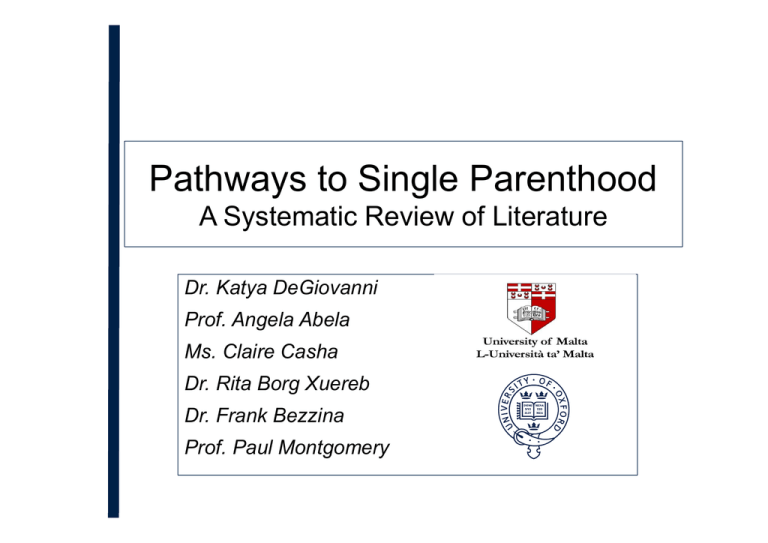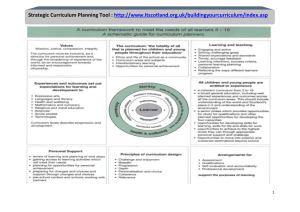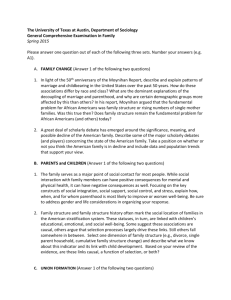
Pathways to Single Parenthood
A Systematic Review of Literature
Dr. Katya DeGiovanni
Prof. Angela Abela
Ms. Claire Casha
Dr. Rita Borg Xuereb
Dr. Frank Bezzina
Prof. Paul Montgomery
Roadmap
1) What is a Systematic Review?
– Goals
– Qualitative Syntheses
2) Systematic Reviews’ role in Evidence-Based
Practice
– The Evidence-Based Practice Clinical Model
3) A Systematic review of Motivation and Trajectories
of Single Parenthood
– Methodology
– Findings
4) Policy implications
2
What is a Systematic Review?
• Identify, collate, and systematically
summarize empirical evidence from
primary research studies on a specific
topic.
– In primary research studies, the unit of
analysis is typically an individual, family,
school, community, etc.
– In a systematic review, the primary research
studies themselves are the unit of analysis.
3
Aim of Systematic Reviews:
Minimization of bias & error
SRs attempt to minimize bias/error in the review
process.
Use systematic, empirical process that values
transparency and replicability:
– Based on protocols that outline explicit ex/inclusion
criteria
– Document transparent search strategies
– Inter-rater reliability on key data extraction decisions
– Study quality/risk of bias assessment
– Meta-analysis (when appropriate) to statistically
synthesize results across studies
4
Qualitative Syntheses
Systematic syntheses of qualitative evidence, sometimes in
context of controlled trials
– Use qualitative findings to provide context for the quantitative
synthesis results.
– Qualitative & quantitative evidence extracted from the same
set of primary studies.
Two modes of qualitative syntheses:
– Parallel synthesis: Conduct a SR of qualitative studies
alongside a separate SR of quantitative studies. Use
qualitative synthesis to interpret findings of the quantitative
synthesis.
– Meta-synthesis: Conduct a SR of qualitative studies
alongside a SR of quantitative studies. Interpret the results of
the two syntheses together.
5
The Evidence-Based Practice
(EBP) Clinical Model
Clinical State
and
Circumstances
Clinical
Expertise
Client
Preferences
and Actions
Current
Best
Evidence
Source: Haynes, Devereaux, and Guyatt, 2002
6
Context of EBP
Political Context
Clinical
Expertise
Client
Preferences
and Actions
Current Best
Evidence
Professional Context
Client State
and
Circumstances
Training / Supervision
Community
Socio / Historical Context
Organizational Mandate
Organizational Resources /
Constraints
Economic Context
7
Levels of Evidence for EBP
Source:
Evidence-Based Practice in the Health Sciences
http://ebp.lib.uic.edu/nursing/node/12
8
Methodology of the Current
Study
Topic:
• Motivation and Trajectories of
Single Parenthood
Pool of studies:
• Originally 997 studies carried out through literature
searches from the most important databases.
Included studies:
• Through discussion in the team, we identified 13
studies for inclusion in the study (References see
appendix)
9
Overview of findings
I. Demographic difference of parents
II. Correlates of parenthood
III. Teenage/Early fatherhood
IV. Childbearing and marriage
V. Cohabitation and attitudes
VI. Perceptions of parenthood and marriage
VII.Miscellanous
10
Findings (I):
Demographic difference of parents
Comparison by:
Gender of parents, Single parent, custodial vs. biological
parents
• Single fathers had significantly higher education than
mothers.
• Adolescents with single fathers had higher levels of family
routines than those with a single mother
• Single custodial fathers had higher income levels than
single mother families but lower levels of income than two
biological parent families.
• Adolescents living with both biological parents were more
likely to graduate from high school than those living with
single parents
11
Findings (II):
Correlates of parenthood
• A 1 year increase in the age of the youth’s mother at the birth of
her first child reduced the baseline odds of conceiving a child by
8%.
• An increase of 1 SD in the youth’s parents SES level reduced
the odds first birth by 26.1%.
• An increase of one SD in the parents’ monitoring of the youth
reduced the odds of single parenthood by 25.3%.
• Good academic skills significantly reduced the odds of fathering
by 33.4% for each increase of one SD whereas each one unit
increase in substance use frequency significantly increases the
odds by 40.4%.
• Both relationship status and failure to use condoms were
significant predictors increasing the odds of fathering a first child
by 421% and 30% respectively.
12
Findings (III):
Teenage/Early fatherhood
•
Males growing up in lower class families have a higher rate (16%) of
teenage fatherhood than those growing up in more middle-class
families.
•
Rates of teenage fatherhood are higher for males whose parents have
lower levels of social support (16%)
•
Those with low scores on achievement tests (21% Reading: 14%
Maths) and those whose parents have low aspirations of them are more
likely to become single fathers (11%)
•
Precocious sexual activity has a significant and sizable impact on the
likelihood of becoming a teen father by 26%.
•
Associating with delinquent peers and being a member of a juvenile
street gang are positively associate with early fatherhood (21%)
•
Frequent involvement in drug use, general delinquency and violence
increase fatherhood at a young age by 43%.
13
Findings (IV):
Childbearing and marriage
Early birth:
– Premarital first birth undermines the possibility
of getting married.
Race
– Among whites, there are many available
mates therefore the young woman is more
likely to marry, however also, this slightly
increases the likelihood of premarital
childbearing.
14
Findings (V):
Cohabitation and attitudes
•
Young women transit into motherhood earlier than young men by 2.5
years younger (Kreider and Fields, 2002).
•
Women who had never lived with their father had the most rapid
transition to parenthood.
•
For women, losing a sibling was associated with a transition to
cohabiting or single parenthood.
•
15% of the children born to cohabiting mothers experience the end of
their parents union by age 1; half by age 5 and two-thirds by age 10.
•
Cultural and interpersonal factors such as pro-marriage attitudes, the
emotional quality of the relationship, church attendance and women’s
trust in men change unmarried parents’ chances of marriage
•
Low-income mothers views about marriage have changed in view of the
economy and divorce laws
15
Findings (VI): Perceptions of
parenthood and marriage
• The disadvantaged ascribe more value to children at an earlier
age than do the middle class and deem childlessness to be a
terrible tragedy.
• They have less to lose by having children early and place
children first in terms of making meaning of their lives.
• Good mothering for them is not seen as something that requires
tremendous resources but it basically includes “being there”
which is a conception of parenting that differs from that of the
middle class.
• Low income women view marriage as an aspiration whereas
parenthood is attainable regardless of financial stability
• Men with few economic resources are more likely than other
men to marry unwed mothers.
16
Findings (VII): Misc
• Mothers who went on to marry and then divorced ended
up economically worse off than those who never married.
• In preparing for motherhood, single mothers were more
concerned about finances than married mothers.
• Mothers who conceived by sexual intercourse were less
likely to mention that a father’s absence is hard on the
child (14%) than whether the adoptive mothers (55%) of
those who conceived by donor insemination.
• In the study by Edin and Kefalas (2011) some women
opted to become pregnant to please their boyfriends or
because they wanted to be loved.
17
Policy implications
Three broad areas:
I. Education
II. Education/information about sex,
families and support
III. Further research
18
Policy Implications (I)
Research implies that more care needs to go into the
educational pathways of our young people:
• Single women are usually less educated and have
a lower income then single men.
• Family routines are important in fostering a better
educational background.
• Females need to be granted more flexibility to work
and also to upgrade their skills. They are still the
ones who undertake the major care burden of the
kids
19
Policy Implications (II)
Public communication:
• Delaying of sexual activity is an important issue
• Schools need to mediate between educational aspirations
for families and capabilities of youngsters
• Strengthen education about relationships and support to
families undergoing difficult transitions
• We need to consolidate on campaigns which encourage a
safe environment and minimise opportunities for drug use,
delinquency and violence.
20
Policy Implications (III)
Further research:
Cross disciplinary work with Health,
Education and Social Policy to develop
effective interventions for Malta.
21
Final remarks
1) What is a Systematic Review?
2) Systematic Reviews’ role in EvidenceBased Practice
3) A Systematic review of Motivation and
Trajectories of Single Parenthood
4) Policy implications
1) Education
2) Information
3) Further research
22
Acknowledgements
This study by:
• DeGiovanni, K., Abela, A., Casha, C., Borg
Xuereb, R., Bezzina, F. and Montgomery, P.
will be submitted to a high impact journal. It is
anticipated to be submitted in the next few
months.
• Anyone who would like a copy of the full study
can contact the Department on:
familystudies@um.edu.mt
23
Appendix: Included studies
•
Bronte-Tinkew, J., Scott, M. E. & Lilja, E. (2010). Single Custodial Father’s Involvement and Parenting: Implications for Outcomes
in Emerging Adulthood. Journal of Marriage and the Family. 72. 1107-1127
•
Creighton, M. J., Park, H. &Teruel, G. M. (2009). The Role of Migration and Single Motherhood in Upper Secondary Education in
Mexico. Journal of Marriage and Family. 71, 1324-1339.
•
De Genna, N. M., Larkby, C. & Cornelius, M. D. (2011). Pubertal Timing and Early Sexual Intercourse in the Offspring of Teenage
Mothers. Journal of Youth Adolescence. 40, 1315-1328.
•
Edin, K., & Kefalas, M. (2005). Promises I can keep: Why poor women put motherhood before marriage. Berkeley, CA: University
of California Press.
•
East, P. L. (1998). Racial and Ethnic Differences in Girls’ Sexual, Marital, and Birth Expectations. Journal of Marriage and the
Family. 60, 150-162.
•
Glick, J. E., Ruf, S. D., White, M. J. & Goldscheider, F. (2006). Educational Engagement and Early Family Formation: Differences
by Ethnicity and Generation. Social Forces. 84(3) 1391-1415.
•
Hertz, R. (2006). Single by chance, mothers by choice: How women are choosing parenthood without marriage and creating the
new American family. New York, NY: Oxford University Press.
•
Included Studies
•
Hofferth, S. L. & Goldscheider, F. (2010). Family Structure and the Transition to Early Parenthood. Demography. 47(2) 415-437.
•
Pears, K. C., Pierce, S. L., Kim, H. K., Capaldi, D. M. & Owen, L. D. (2005). The Timing of Entry into Fatherhood in Young, At
Risk, Men. Journal of Marriage and the Family. 67, 429-447.
•
Siegel, J. M. (1998). Pathways to Single Motherhood: Sexual Intercourse, Adoption, and Donor Insemination. Families in Society.
79(1) 75-82.
•
Smock, P. J. & Greenland, F. R. (2010). Diversity in Pathways to Parenthood: Patterns, Implications, and Emerging Research
Directions. Journal of Marriage and the Family. 72, 576-593.
•
South, S. J. (1996). Mate Availability and the Transition to Unwed Motherhood: A Paradox of Population Structure. 58, 265-279.
•
Thornberry, T. P., Smith, C. A. & Howard, G. J. (1997). Risk Factors for Teenage Fatherhood. Journal of Marriage and the Family.
59, 505-522.
24
Questions/Discussion
25







